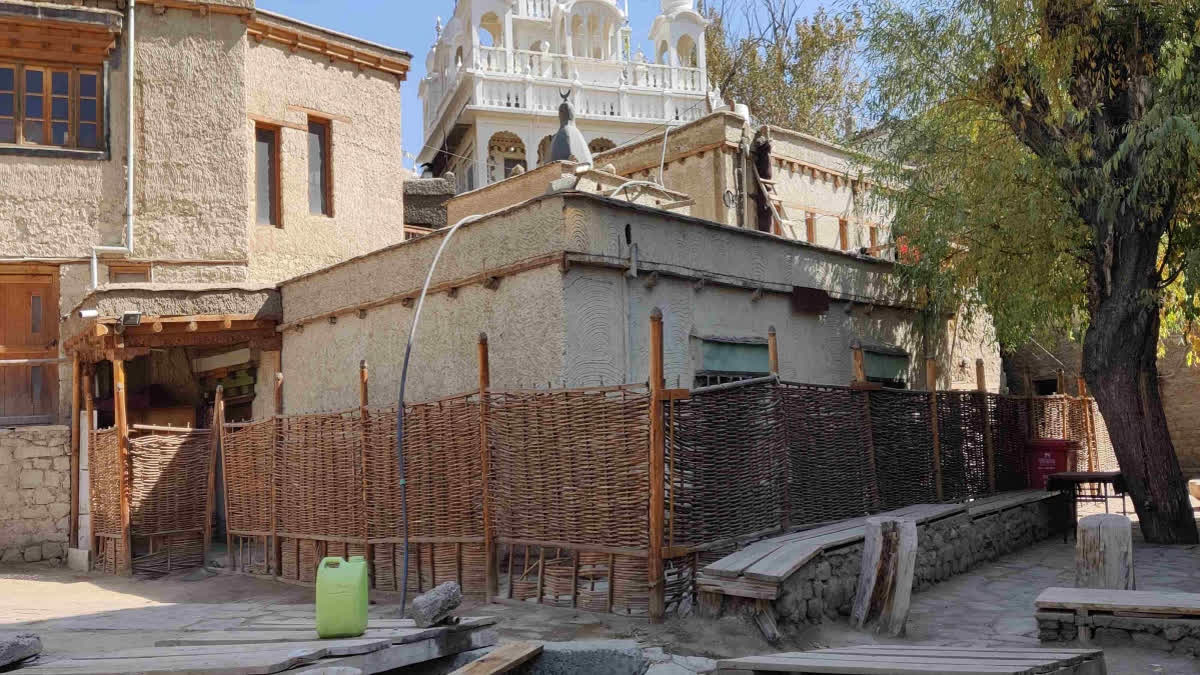Leh: The Tsas Soma Mosque, located in the heart of Leh, Ladakh, is a significant historical monument that dates back to the 17th century. It was constructed during a period when Leh was a thriving hub of trade along the ancient Silk Route, attracting traders from Central Asia, Kashmir, Punjab, and beyond. These traders, many of whom were Muslims, needed a place to gather and offer prayers, which led to the establishment of the Tsas Soma Mosque. The mosque was used as a place of worship by women and also served as a Madrasah.
Today, the Tsas Soma Mosque continues to serve as a place of worship for the local Muslim community. The mosque stands as a reminder of Ladakh's diverse and interconnected past, where trade, faith, and culture came together.
In 2007, the Tibet Heritage Fund (THF) collaborated with the Anjuman Moin ul-Islam Society to restore Leh's oldest Mosque, Masjid Sharif, located in the Tshas Soma garden in the Chutay Ranthak area of the old town.
Dr. Abdul Qayum, President of Anjuman Moi Ul Islam, said, "Leh was at the heart of this trade network, attracting merchants from Lhasa, Punjab, Kashmir, and likely even China. Traders from as far as Iran and Europe passed through, while many Central Asian traders, especially from the Nubra Panamik region, made regular visits."
"A large number of these traders were Muslims, and they would gather with their caravans, including camels, at Tsas Soma. The 'Tandoor' bakeries which is known in Central Asia continue to exist in Leh. We have worked to restore and preserve this mosque in its traditional form. The call to prayer (azaan) and the five daily prayers (namaz) are still observed here," added Qayum.
Dr Noor Mohd, executive member of Anjuman Moin Ul Islam said, "This mosque is the one of the oldest public mosques in Leh town. This Tsas Soma area used to be one of the camping grounds for Central Asian caravans. Another camping ground was near the police station and CMO office, the third was near the taxi stand Zangsti. These three were mostly used by Central Asian traders and their animals were also kept there. The fourth was Balkhang where people from Baltistan used to stay there."
He added, "The mosque was functional till the 1950s and later on it was in dilapidated condition and was abandoned because the main mosque was completed by that time. Later, THF in collaboration with Anjuman Moin Ul Islam restored and expanded the mosque. The main door and the beams are kept original and it is very old. This mosque, once a centre for public worship, also witnessed numerous barter trades conducted by the visiting caravans."
How it turned from a caravan to Mosque
Dr. Noor explained, "Most of the traders from Central Asia were Muslims, and at that time, there was no designated place for them to pray in Leh town. The Muslim traders requested King Singey Namgyal to provide them with land for a mosque. In response, the king allotted this area for the Muslim caravans, where a small mosque was built."
"The Tsas Soma area served as one of the key camping grounds for these traders. Some relics, such as the original mehrab, are still preserved. Today, many visitors come to see the mosque, as it now forms part of the Central Asian Museum compound," added Dr Noor.
Historian Ghani Sheikh in his article published in Stawa magazine titled, ‘Islamic Architecture in Ladakh’ writes, "Sometime after 1620, conceding to the request of Muslim traders conducting business in Leh, Sengge Namgyal gave a small piece of land to them to build the Tshas Soma or New Garden Mosque. It is the oldest public mosque in Leh, though now abandoned, and even at that time used only for a short period."
He further writes, "The mosque is a single-storey building consisting of one large room with a small entrance doorway at the side. There are six wooden pillars, their capitals carved at the top in the Ladakhi style but they are not painted. The mosque has no minaret and though it had a wooden dome this now adorns the Shah Hamdan Mosque at Shey.”
"This mosque was used till the 1950s –some individuals offered prayer in it but no congregation was held,” he writes.
Monisha Ahmad, Social Anthropologist and Founder of Ladakh Arts and Media Organisation writes in her memoir to Late Historian Abdul Ghani Sheikh, “He (Abdul Ghani Sheikh) advocated for the importance of restoring historical buildings to protect Ladakh’s rich heritage for future generations. He is best remembered for initiating the restoration of Leh’s first public mosque, Tshas Soma which was built in the 17th century”.



